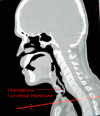Gossypiboma larynx: a rare cause of post-tracheostomy stridor-case report and review of literature
- PMID: 38886746
- PMCID: PMC11184822
- DOI: 10.1186/s13256-024-04490-7
Gossypiboma larynx: a rare cause of post-tracheostomy stridor-case report and review of literature
Abstract
Background: Gossypiboma, a retained surgical sponge with a foreign body reaction, is an unusual but serious complication seen in open abdominal surgeries. It is exceptionally rare following head and neck surgeries. Here, we present a case of Gossypiboma of the upper airway following tracheostomy.
Case presentation: A 32-year-old male presented with stridor and difficulty breathing one-month post-tracheostomy after a severe head injury following a road traffic accident. A neck radiograph was unremarkable, and a computed tomography (CT) scan of the neck showed a well-defined homogenous curvilinear membrane extending from the hypopharynx to the upper trachea. Bronchoscopic evaluation of the larynx and upper trachea revealed a retained surgical sponge, which was retrieved. The patient's breathing improved drastically post intervention.
Conclusion: Gossypiboma may go undetected in radiographs and may also present atypically as a homogenous membrane on a CT scan of the neck. Though rare, retained surgical items can have profound medicolegal and professional consequences on physicians. Hence, a strong clinical suspicion and vigilance for gossypiboma is necessary for patients presenting with respiratory distress post-tracheostomy.
Keywords: Bronchoscopy; Foreign body; Gossypiboma; Laryngeal membrane; Larynx; Stridor; Surgical gauze; Tracheostomy.
© 2024. The Author(s).
Conflict of interest statement
The authors have no relevant competing interests to declare.
Figures
References
Publication types
MeSH terms
LinkOut - more resources
Full Text Sources
Medical



